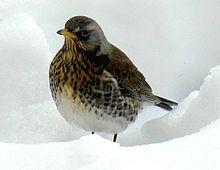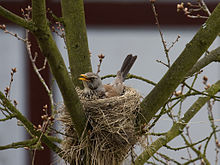Fieldfare
| Fieldfare | ||||||||||||
|---|---|---|---|---|---|---|---|---|---|---|---|---|

Fieldfare ( Turdus pilaris ) |
||||||||||||
| Systematics | ||||||||||||
|
||||||||||||
| Scientific name | ||||||||||||
| Turdus pilaris | ||||||||||||
| Linnaeus , 1758 |
The Fieldfare ( Turdus pilaris ) is a bird art from the family of thrushes (Turdidae). This large thrush species inhabits the central and north-eastern Palearctic from Scotland and central France eastwards to the Amur in Siberia . It inhabits semi-open landscapes, in Central Europe mainly forest edges and groups of trees with adjacent moist grassland. The species has expanded its range strongly to the west in the last 200 years or so and is now a moderately frequent breeding bird in eastern Central Europe. The field thrush is predominantly short-range migrant and spends the winter mainly in central and southwestern Europe and in the Mediterranean region .
The species was previously called Krammetsvogel (more rarely: Kramtsvogel, Krammetvogel or Krummetvogel), the name is derived from the old name Krammet (also: Kranewitt) for the juniper .
features
With a body length of 22 to 27 cm, the field thrush is only slightly smaller than the better-known blackbird , but slightly longer-winged than this and significantly heavier. Compared to the other thrushes in Central Europe, the species is strikingly colorful, the sexes do not differ. In adult birds the upper back, shoulder feathers and upper wing-coverts are reddish brown; The head, back and side necks and the back and lower back are light gray. The head shows a distinct whitish stripe above the eyes . The throat, front neck and upper chest are blackish dashed on a yellow ocher background, the flanks show dark, arrowhead-like spots on a mostly slightly paler reddish beige background. The rest of the underside of the trunk, the under tail-coverts and the under wing coverts are white. The wings are dark gray-brown and have a narrow, light border. The tail is blackish gray.
The legs are dark brown, the beak is yellow to yellow-orange with a dark tip. The iris is dark brown.
Vocalizations
The less melodic singing is mainly performed in flight. He is pressed chirping with high-pitched and croaking tones; the fluting motifs typical of other thrushes are missing. Migrants and winter guests shout hard and pressed "gii" and, above all, often harshly chacking "schack, schack, schack". If the nest is disturbed, a scratching "trrtrrtrr" can be heard.
distribution and habitat
The field of distribution of the fieldfare includes large parts of the central and northeastern Palearctic of Scotland and central France to the east to the upper reaches of the Amur in Siberia . In north-south direction, the distribution in Europe extends from the northern tip of Norway to the southern edge of the Alps and into central Ukraine . The species has expanded its area significantly to the west in the last 200 years or so. In the mid-19th century, the western border of the closed area in Europe ran e.g. B. still through Mecklenburg-Western Pomerania , Saxony-Anhalt , Thuringia and Upper Franconia . The causes of this area expansion are unclear.
The field thrush lives in semi-open landscapes, in Central Europe mainly forest edges and groups of trees with adjoining moist grassland, but also orchards, parks and larger gardens. In Siberia, the species also lives in highly loosened deciduous and mixed forests, especially in the vicinity of rivers. In general, small-scale, moist and cooler habitats are preferred. Important habitat elements are areas with fresh to moist soils and low grassy vegetation for foraging and tall trees and bushes for nesting; Feeding flights usually only take place up to 250 m away from the breeding site.
nutrition
The diet consists of both animal and vegetable components. In spring and summer, earthworms are predominantly consumed, along with other invertebrates . Berries and other fruits including windfalls are eaten from mid-June; these form the majority of the diet in autumn and winter. Whether the field thrush also belongs to the mistletoe-spreading birds, as was sometimes claimed, has yet to be finally clarified.
Reproduction
The fieldfare usually breeds in small colonies, but also individually. Especially colony breeders nest environment defend very strongly with dives against corvids and raptors , but also against other nest enemies. Not infrequently they try to make the troublemaker temporarily or permanently incapable of flight by joint pecking (with "excrement bombs"). The nest is built on trees and tall bushes, often on old trees and then conspicuously open in the fork of the trunk or on strong branches on the trunk. It consists of coarse blades of grass or leaves on the outside and at the base. This “shell” is lined with wet earth and the bowl is then covered with a layer of fine blades of grass.
In Central Europe, eggs are laid at the end of March at the earliest, mostly in April. Second broods occur regularly in Central Europe, the last clutches are started here at the end of June. The clutch consists of 2–7, mostly 5–6 eggs, which are very variably red-brown spotted on a light bluish-green background. The breeding season lasts 10–13 days. The incubation is carried out exclusively by the female; the nestlings are also only hovered by the female up to the age of 9-10 days, but then fed by both parents. The young birds can already fly well with 18 days, with about 30 days they are independent.
hikes
The field thrush is predominantly a short-distance migrant in Central, Eastern and Northern Europe . The withdrawal from the breeding areas takes place from the end of September and lasts until the end of November. The birds overwinter mainly in Central and Southwestern Europe as well as in the Mediterranean area . Fieldfare are gregarious outside of the breeding season; they move and rest in troops or small flocks and often rest in the open countryside on meadows or fields. They migrate home through Central Europe from mid-February, depending on the geographical location, the breeding grounds are mostly occupied from March and into April.
Existence and endangerment
There is no reliable information on the world population , the IUCN gives a rough estimate for the European population of 28 to 48 million individuals. According to the IUCN, the species is not endangered (LC).
use

In the past, the birds, especially during migration times, were also in Central Europe e.g. T. caught en masse. Krammetsvögel are mentioned in numerous old recipe books.
From a 1911 cookbook:
“The Krammetsvögel are plucked, the skin pulled from the head, singed, the intestines removed through the anus opening. Then you wash the birds, stab your eyes, knock your claws off your feet, bend your head over your chest and stick your feet crosswise through your eye sockets. The birds are rubbed with salt and some crushed juniper berries. Then butter is made light brown in a pan, about ½ tablespoon for a thrush, and roast the birds for about half an hour, turning them frequently. Pour some water into the sauce. The birds are not gutted. You can serve the Krammetsvögel on toasted bread rolls and add sauerkohl. "
The fieldfare was caught with snares, formerly called dohne , made of horse hair. The nooses were hung in or near rowan berries with fruits. Rowanberry tufts were hung under the nooses. Many thrushes died in agony because they did not suffocate immediately, but wriggled to death. In the Sauerland, catchers got 11 to 18 pfennigs per bird at the beginning of the 20th century. In the German Empire, catching fieldfare and other thrush species with snares was banned on May 30, 1908. This was achieved above all through the personal commitment of Lina Hähnle and the educational work of the Federation for Bird Protection (BfV), which she founded, the forerunner of today's NABU .
literature
- L. Svensson, PJ Grant, K. Mullarney, D. Zetterström: The new cosmos bird guide . Kosmos, Stuttgart 1999, ISBN 3-440-07720-9 , pp. 274-275.
- E. Bezzel: Compendium of the birds of Central Europe. Passeres - songbirds. Aula, Wiesbaden 1993, ISBN 3-89104-530-1 , pp. 246-253.
Web links
- Turdus pilaris in the endangered Red List species the IUCN 2008. Posted by: BirdLife International, 2004. Retrieved on January 3 of 2009.
- Videos, photos and sound recordings of Turdus pilaris in the Internet Bird Collection
- Javier Blasco-Zumeta, Gerd-Michael Heinze: Fieldfare (PDF; 1.4 MB; English).
- Fieldfare feathers
Individual evidence
- ↑ Helga Hofmann: Identifying garden birds made easy . 20th edition. Gräfe and Unzer, Munich 2018, ISBN 978-3-7742-5669-9 , pp. 66 .
- ↑ UN Glutz v. Blotzheim, KM Bauer: Handbook of the birds of Central Europe . Vol. 11, Part II. Aula Verlag, Wiesbaden 1988, ISBN 3-89104-460-7 , p. 1007f.
- ↑ Examples for Krammetsvogel recipes on kirchenweb.at accessed on June 21, 2016.
- ↑ M. and E. Doennig: Cookbook of the East Prussian household school. 6th edition. Königsberg 1911, p. 147.
- ^ Heinrich Schauerte: Krammetsvögelfang in olden times . De Suerländer 1961: 81-82.
- ↑ Birds of Paradise campaign 1910 - NABU. Retrieved January 22, 2020 .




